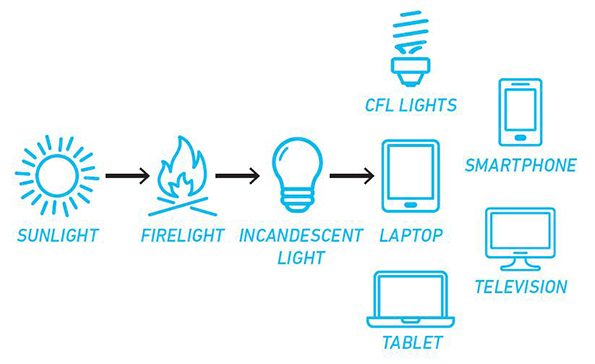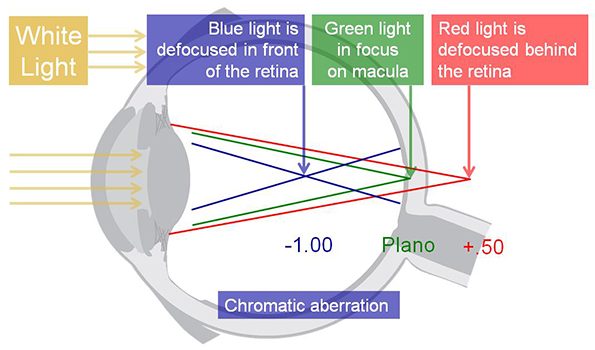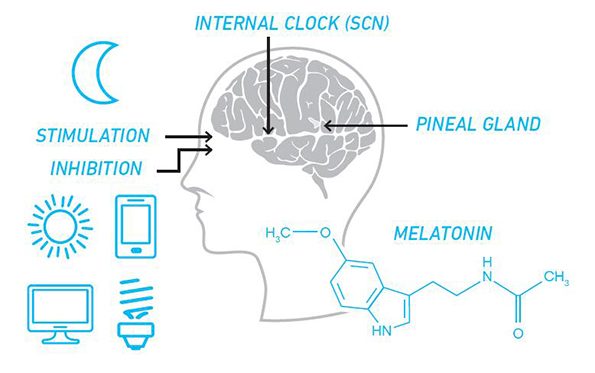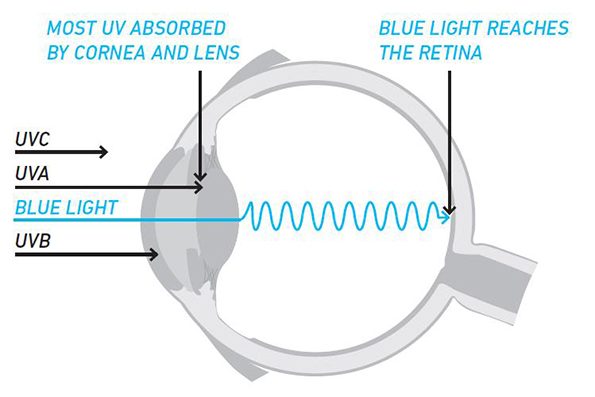Blue light, part of the visible light spectrum, has always been present in our environment through sunlight. However, as technology advances, we are exposed to blue light at higher levels than at any point in our history. Blue light is present in energy efficient LED and CFL lighting, fluorescent lighting, and backlit screens, including TVs, tablets, computers, and smartphones. The blue light emitted by LED backlit screens is especially concerning because close proximity of the blue light source to the eye greatly increases the impact of the exposure.

Image courtesy of VSP
Dr. Walters educates her patients on the importance of limiting blue light exposure. In recent years, overexposure to blue light had been proven to contribute to three major health concerns: eye strain and fatigue, Macular Degeneration, and sleep disruption.
Eye strain and fatigue may be the most commonly occurring complaint from blue light exposure. Individuals who spend multiple hours a day on a computer experience sore, tired eyes, and headaches. Blue light contributes to these symptoms by how the light is focused. After light enters the lens, blue light defocuses in front of the retina, causing visually uncomfortable glare. The eye also has to constantly work to pull the light back into focus, causing eye strain.

image courtesy of VSP
Macular Degeneration, also referred to as Age-Related Macular Degeneration, or AMD, is a progressive disease which can result in the loss of central vision. Historically, AMD has been identified as a disease of the aging population, however increased sources of and exposure to blue light has caused a shift to develop in those affected by this disease. Unlike UV light, which is mostly absorbed by the cornea and lens, blue light penetrates to the back of the eye, damaging the macular and retinal tissue.

image courtesy of VSP
We have a natural filter in the form of macular pigment, which can protect from blue light exposure. This yellow pigment absorbs blue light, allowing for less of an impact on the macula and retina. Over time, extended exposure to blue light can break down this layer, resulting in less protection from the harmful effects of blue light, contributing to the development of AMD.
Sleep disruption is a highly publicized effect of blue light exposure. The human sleep cycle is regulated by light. When the sun is up, we are more alert, and when the sun goes down, we enter a restful state and sleep. This cycle exists because sunlight, which contains blue light, signals the SCN (Suprachiasmatic Nucleus) to inhibit melatonin secretion in the pineal gland. Melatonin, a naturally-produced hormone, allows for the human body to enter a restful state and achieve deep sleep. When the sun goes down, the SCN triggers the pineal gland to produce the melatonin necessary for sleep.
Blue light exposure at night, often from TVs, smartphones, tablets, and computers, disrupt this cycle by invoking the same stimulus response as sunlight, signaling the body that it is time to be awake. This disruption makes it more difficult for individuals to fall asleep and enter deep sleep.

image courtesy of VSP
Children are more susceptible to the effects of blue light. Children typically have larger pupils and clearer lenses, allowing more light to enter the eye. Additionally, the macular pigment layer which protects your macula and retina from the effects of blue light does not develop until adulthood. Protective measures for children is even more imperative as consistent blue light exposure is beginning at younger ages.
Controlling your exposure to blue light by limiting your time spent on devices that emit blue light is a step in the right direction. However, in today’s world, it is not always a practical answer to the blue light problem. Our doctors prescribe BluTech Lenses to our patients who have increased exposure to blue light, a lower macular pigment density, are at increased risk of developing Macular Degeneration, or have been diagnosed with Macular Degeneration. These lenses are injected with ocular lens pigment and melanin, which are the natural components within our eyes that filter blue light.
Proper nutrition and supplementation are also key tools in protecting your vision from the dangers of blue light.







